This dish makes us so nostalgic for the Cinque Terre. We went there as a short honeymoon and the beauty and wonderful flavors of the region did us in. We fell in love all over again. I can't say too much about this recipe without getting a little glassy eyed and so will just post this recipe as is. The basil was from our garden, but we brought back some olive oil from the Ligurian region to get a more "authentic" taste. Ingredients 1/2 pound trofiette pasta or other short tubular shape 4 oz. fresh basil 4 tablespoons of grated Parmesan cheese or Pe 2 tablespoons pinoli nuts (pine nuts) 3 cloves garlic 1/2 cup extra virgin olive oil (light in flavor) Salt for pasta water and to taste, blanched string beans(optional) boiled potatoes(optional) Wash the basil leaves in cold water and dry them on a towel. With a marble mortar and wooden pestle pound the garlic into a paste. The garlic should not overwhelm the basil. Add some salt and grind it into the garlic paste. Add the basil a little at a time and with a gentle swirling motion grinding it into the garlic. You get the best taste by gently grinding the leaves. At this point add the pine nuts, a handful at a time. When the nuts are soft and incorporated start adding the cheese. Begin to add the extra virgin olive oil. It is important the flavor of the oil is light so that it doesn’t overwhelm the flavor of the basil. The light olive oil of the Luguria blends perfectly with the basil mixture. Boil the water salting it sufficiently and drop in the trofiette. Toss it well with the pesto and serve the grated cheese either Parmesan or Pecorino on the side. Drizzle the same light extra virgin olive oil over the top. 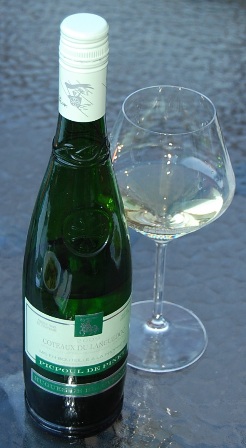 2009 Hugues de Beauvignac Coteaux du Languedoc Picpoul-De-Pinet A Cinqueterre DOC would be my favorite pick for this traditional Ligurian dish. However, since these wines are hard to find outside of their region, I have selected a fresh Southern French one. Picpoul blanc is a grape variety grown mostly in the Languedoc region and it produces light bodied and lemon flavored wines. This wine has been vinified in stainless steel temperature controlled vats and neither underwent malolactic fermentation nor saw oak barrels. Tasting notes: Pale straw color with green shimmers. Citrus driven nose, along with wet rocks and floral notes. Light bodied, lively and elegant wine, with a relatively low acidity that provides a good balance, as this wine is not on the fruity side. The flavor is mostly fresh crushed lemon (retail $9.99 - AVIN3572954729636).
0 Comments
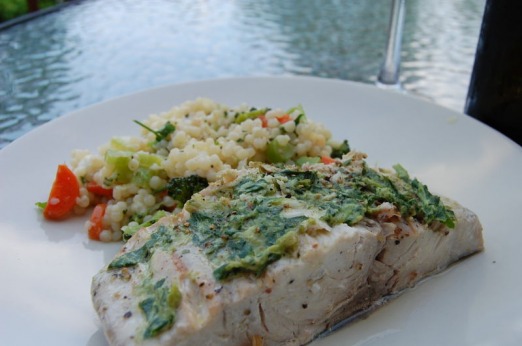 I bet anyone who likes the beach and seafood is really upset about the oil spill incident that recently occured in the Gulf. I, for one am VERY heartbroken and concerned about the future impact to the flora and fauna of the underwater world. So, it is with a sad heart and a mourning spirit, that Nic and I decided to treat ourselves to a gulf delicasy of Mahi-Mahi, along with an Israeli couscous salad with mixed vegetables. In case you are not acquainted with delicious mahi-mahi, first let me say that although it is sometimes called "dolphin-fish", it is NOT related to the DOLPHIN as we know it! 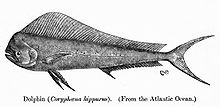 This is an illustration of the Mahi fish. These fish are surface dwelling, ray-finned fish found in off shore temperate, tropical, and sub tropical waters around the world. they average somewhere between 15- 29 pounds,and have a mild taste similar to whitefish, tilapia, or flounder. Pesto Sauce: 1/3 cup of olive oil 1 clove of garlic juice of one lemon dash of salt half cup cherry or grape tomatoes 1/3 cup of chopped basil leaves 3-4 tablespoons of chopped flat leaf parsley Directions: Mix all the ingredients together in a food processor. Set aside Oven Seared Mahi-Mahi with Pesto Serves 2 2 mahi-mahi filets 3 tablespoons pesto 2 Tbsp olive oil Kosher salt and black pepper Extra olive oil for greasing pan 1. Grease a glass baking dish with a very small amount of olive oil. 2. Season both sides of the mahi-mahi with salt and pepper and then coat the top of each mahi-mahi filet with 1Tbsp olive oil 3. Place the filets in the baking dish, and bake at 350 degrees for 15-20 minutes, or until the fish flakes easily with a fork. Top with pesto and serve immediately. Mixed Vegetable Israeli Couscous 2 cups chicken broth or water 1 cup Israeli couscous 1 teaspoon olive oil 1/2 teaspoon salt 3/4 cup chopped grape tomatoes or cherry tomatoes, cut in half 3/4 cup chopped broccoli 1/4 cup chopped red onion 3 green onions, chopped 1/2 cup chopped parsely 1/2 teaspoon hot pepper flakes (optional) Juice of 1 lemon 3 tablespoons olive oil Salt and pepper to taste Bring broth or water to boil. Add couscous, olive oil and salt. Simmer for about 10 to 12 minutes or until tender to the bite. Drain and cool couscous. Combine couscous with broccoli, tomatoes, red onion, parsley and hot pepper flakes. Whisk together remaining ingredients and combine with couscous mixture. Season with additional salt and pepper to taste. Makes 4 to 6 large side servings. 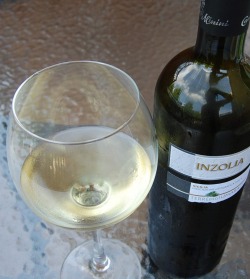 2008 Terre di Giumara Inzolia
Inzolia is one of the oldest native white grapes of Sicily. It is planted also in Sardinia, Latium and Tuscany, where it is known as Ansonica. Its vine is very resistant to the dry weather and has sparse foliage, requiring less water. This is one of the three main grape varieties used in Marsala production, but it is often bottled as a dry white table wine. This wine is fermented at controlled temperature for 20 days, then aged 4 months in stainless steel tanks and 2 months in the bottle. Tasting notes: It has a light golden color. The nose opens with tangerine, ripe pear and minerals, but it translates to citrus fruit and chamomile flowers on the palate. Light bodied and tart with a persistent and intense finish. (retail $11.99 - AVIN6719568292348). Originally, this dish known as BUCATINI ALL'AMATRICIANA, because it was named for the tiny town of Amatrice located about 100 miles east of Lazio from Abruzzo, near Rome. But we are calling this dish ALL'AMERICANA because we slightly changed the traditional ingredients, and added some local flair. Serves 4 1/4 pound american bacon(we used the organic kind) half pound ground buffalo 3 garlic cloves 1 red onion, halved and sliced ½-inch thick 1 ½ teaspoons hot red pepper flakes Kosher salt and freshly ground black pepper, to taste 1 ½ cups basic tomato ragu(we used a jar brand) 1 pound bucatini dried pasta 1 bunch of flat-leaf parsley, leaves only Pecorino Romano, for grating 1. Bring 6 quarts of water to a boil and add 2 tablespoons of salt. 2. Place the bacon slices in a 12- to 14-inch sauté pan in a single layer and cook over medium-low heat until most of the fat has been rendered from the meat, turning occasionally. Remove the meat to a plate lined with paper towels and discard half the fat, leaving enough to coat the garlic, onion and red pepper flakes. Brown the buffalo in the same pan until done. Return the bacon to the pan with the vegetables, and cook over medium-high heat for 5 minutes, or until the onions, garlic and bacon are light golden brown. Season with salt and pepper, add the sauce, reduce the heat, and simmer for 10 minutes. 3. Cook the bucatini in the boiling water according to the package directions, until al dente. Drain the pasta and add it to the simmering sauce. Add the parsley leaves, increase the heat to high and toss to coat. Divide the pasta among four warmed pasta bowls. Top with freshly grated Pecorino cheese and serve immediately. 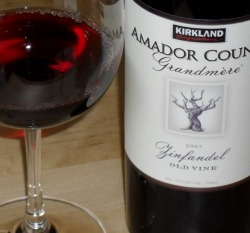 2007 Kirkland Signature Grandmère Amador County Old Vine Zinfandel
Since the bucatini have been made "all' Americana", I picked the American wine for excellence to pair with the dish: red Zinfandel. I would not do it for the Italian style pasta, but the addition of bison meat asks for a bigger wine. Kirkland is Costco's private label, and I have purchased this wine because I'm tasting it along with other variety for a post on b8wine. Tasting notes: Dark ruby color. Deep nose of blackberry, black cherry, spices and mocha. Full bodied with round tannins and silky texture. Meaty and jammy. It has layers of ripe dark fruit and mocha with some pepper on the top. Well balanced acidity and a lingering finish with aftertaste of coffee beans. This wine is big and ripe (the fruit tastes almost sweet) and has 15.5% ALC without being hot. The price in Georgia is $12.99, and overall it's a good value. This was a wonderful combination of flavors. I got the inspiration from a traditional Vodka sauce, but decided to try adding some Fino sherry instead. It was certainly a delicious success. 4oz Salmon (cooked or broiled for 5 mins) 2Tbsp olive oil frozen peas 2 Tbsp tomato paste 1/4 cup fish stock or water 1/2 cup chopped onions 4 Tbsp heavy whipping cream 1/4 cup Fino sherry fettuccine pasta Cook pasta per directions. In the meantime, saute onions in oil over med heat. When onions are translucent, add tomato paste and cream until well distributed. Pour in the sherry and the fish stock and cook until boiling. Reduce heat to simmer and add frozen peas and salmon. Toss with pasta and season with salt and pepper. 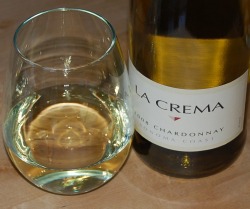 2008 La Crema Sonoma Coast Chardonnay
Salmon and Chardonnay is one of our favorite pairings. This fish is so rich, that can be paired with light red wine too; however we prefer a full bodied white. Chardonnay is all about winemaking. As the grape itself is quite neutral in aroma and flavor, what the wine will become depends on the work done at the winery. The grapes for this vintage have been harvested from cool vineyard sites in the Sonoma Coast AVA. In order to achieve a richer texture, 70% of the wine underwent malolactic fermentation, and it has been aged on its lees for 7 months in mostly French oak (20% new). Here we wanted to pair the creaminess with the dish with the creamy texture of a barrel aged Chardonnay. Tasting notes: Clear, light golden color. Pineapple, butterscotch and a hint of minerals on the nose. Full bodied with creamy texture and a surprising acidity. The palate confirms the nose, with the addition of a lemon/lime note on the finish. Good balance of ripe fruit and new oak influence, with a fresh kick of acidity. Tasted at room temperature, it finishes a little hot, but below 60°F it is hard to perceive. The problem with this wine is that the longer it stays open the more it smells and taste like oak and vanilla only (retail $16.99 - AVIN7104634614855) . |

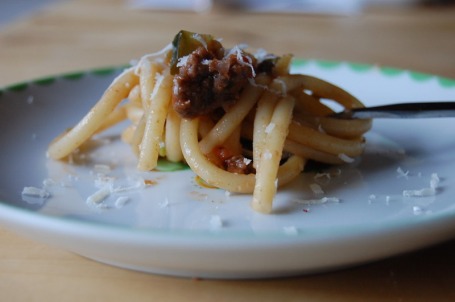
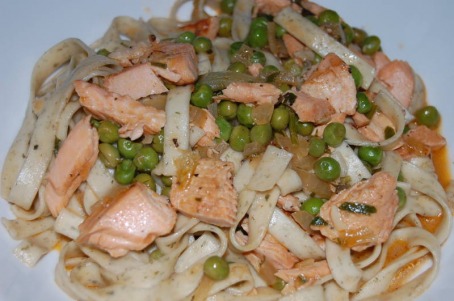

 RSS Feed
RSS Feed